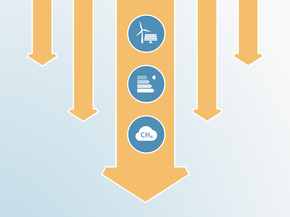Country summary
Overview
Peru’s progress in advancing climate policy continues to be slow. Following the ousting of President Pedro Castillo in 2022, President Dina Boluarte’s government has been in turmoil, plagued by scandal and conflict with the legislature, increasing political instability and contributing to slower policy development overall while failing to slow greenhouse gas emissions.
Despite these challenging circumstances, there has been some movement in the climate policy space. Peru’s recently published National Climate Change Strategy for 2050 sets targets for 2030 and 2050, further clarifies Peru’s net zero target of 2050, and serves as the main policy instrument to drive and coordinate Peru’s long-term response to climate change.
We rate Peru’s unconditional NDC target as “Almost sufficient” when compared with its fair-share contribution to climate action, and the conditional NDC target as “Insufficient” when compared with modelled domestic emissions pathways. Peru’s next NDC submission should include a robust and ambitious target for 2035 and a revised 2030 target that aligns with a 1.5°C pathway.
Peru’s greenhouse gas emissions, excluding land use and forestry (LULUCF), have doubled since 1990. Under current policies, emissions are projected to increase further, reaching up to 148% above 1990 levels. While Peru is likely to achieve its current 2030 NDC target without introducing new policies, this target falls short of what’s needed to align with the Paris Agreement’s 1.5°C temperature limit. This represents a missed opportunity for Peru to raise its climate ambition at a critical moment for global action. To be in line with 1.5°C, Peru would need to set an unconditional target to reduce its emissions to 118 MtCO2e in 2030 and to 112 MtCO2e in 2035, 9-18% and 19-30% below current policy projection levels, respectively.
Despite the continued growth of Peru’s GHG emissions, the country has made some progress in setting up a policy framework for climate action. The 2018 Framework Law on Climate Change and a 2022 decree have established climate change as a national emergency. In late 2024, Peru released an updated National Strategy on Climate Change to 2050 (ENCC), which sets sectoral targets and measurable indicators for both 2030 and 2050. However, overall progress on climate policy has been hampered by significant political instability. The removal of President Castillo in late 2022 and the subsequent transition to President Boluarte, who faces historically low approval ratings, have led to slow and inconsistent climate action. This instability, coupled with a lack of political will and record-low public trust, continues to delay policy implementation in the country. Policy implementation will be critical for Peru to reverse the growth trend seen in its historical emissions and align with 1.5°C.
Peru continues to invest in fossil fuels in moves that are not 1.5°C aligned or compatible with its own net zero by 2050 target, despite some growth in renewable electricity. The government has approved new oil extraction projects and plans to increase oil and gas production by 24% in 2025 – this is not aligned with Peru’s own climate targets. At the same time, Peru has taken the first steps to promote green hydrogen as part of its energy transition.
Deforestation remains a major challenge – between 2021-2024 Peru lost 705 kha of forest, equivalent to 453 MtCO2e of emissions. The expansion of cocoa and palm oil crops is one of the main drivers of deforestation. Recent regulatory changes have rolled-back environmental protections, potentially formalizing deforestation and threatening indigenous rights.
Peru has entered into carbon credit agreements with Switzerland and Singapore, allowing these countries to count emission reductions achieved in Peru towards their own climate targets. These deals risk selling emission reductions that are relatively inexpensive or would have occurred anyway, leaving Peru with fewer and more costly options to increase its own mitigation ambition. Finance generated through the purchase of carbon credits (ITMOs) under Article 6 should not be counted as climate finance. ITMO transactions are designed to help the buying country achieve its targets, while the selling country (in this case, Peru) must make a corresponding adjustment that effectively makes the achievement of its own target more difficult.
Recent positive policy developments include:
- Peru has established a strong legal basis for climate action through the updated National Strategy on Climate Change to 2050 (ENCC) which also sets measurable sectoral targets and indicators for both 2030 and 2050.
- The share of renewable energy in electricity generation has increased (although it remains low), and Peru has introduced a law to promote green hydrogen development.
To improve its climate targets and action rating, Peru could:
- Submit a new and ambitious 2035 NDC which clearly outlines the different sectors' contributions to the mitigation target, in particular from the LULUCF sector, and includes a revised and significantly more ambitious 2030 target.
- Stop investing in the fossil fuel industry. The government continues to approve new license contracts for oil extraction, located in the middle of the Amazon region. These investments in oil extraction not only risk becoming stranded assets but are at odds with Peru’s legal commitment to be net zero by 2050.
- Reverse rollbacks in the LULUCF sector. The largest share of deforestation is due to illegal activity, but recent amendments to the Forestry and Wildlife Law that loosen permitting requirements for landowners to convert forested land to other uses pose a major risk and threaten to legitimise and even incentivise illegal deforestation.
- Further develop a regulatory framework to support the rollout of renewables. The lack of a regulatory frameworks that support a clear, orderly and accelerated energy transition drove Italian multinational Enel out of the country in 2023. A missed opportunity for retaining and expanding investment and exploiting Peru’s significant renewable potential.
Description of CAT ratings
The CAT rates each country’s targets and policies against (1) its fair share contribution to climate change mitigation considering a range of equity principles including responsibility, capability and equality, and (2) what is technically and economically feasible using modelled domestic pathways which in absence of a better method are based on global least-cost climate change mitigation.
Comparing a country’s fair share ranges and modelled domestic pathways provides insights into which governments should provide climate finance and which should receive it. Developed countries with large responsibility for historical emissions and high per-capita emissions, must not only implement ambitious climate action domestically but must also support climate action in developing countries with lower historical responsibility, capability, and lower per-capita emissions.
The CAT rates Peru’s climate targets and policies as "Insufficient." The “Insufficient” rating indicates that Peru’s climate policies and commitments need substantial improvements to be consistent with the Paris Agreement’s 1.5°C temperature limit. Peru’s 2030 emission reduction targets would lead to 3°C of warming when compared to modelled domestic emissions pathways and to at least 2°C of warming when compared to Peru’s fair share contribution to climate action.
Peru’s current policies would lead to emissions far above or just at the unconditional target level, highlighting that Peru needs to urgently implement further, more ambitious policies if they are serious about keeping their climate commitments and meeting their NDC.
To get a better rating, Peru would need to set more ambitious climate targets of at least 118 MtCO2e in 2030 and 112 MtCO2e in 2035, 9-18% and 19-30% below current policy projections, respectively, and establish associated policies that can curb the growth in national emissions and set them on a downward trend.
Our analysis shows that under an optimistic scenario Peru may be able to achieve its unconditional NDC target with its current policies. Peru’s current policies are “Almost sufficient” when compared to its fair-share contribution. However, when compared to modelled domestic pathways, Peru’s current policies are rated as "Highly insufficient."
The “Almost sufficient” rating indicates that Peru’s climate policies and action in 2030 are not yet consistent with the 1.5°C temperature limit but could be, with moderate improvements. If all countries were to follow Peru’s approach, warming could be held at—but not well below—2°C. Peru is expected to implement additional policies with its own resources, but will also need international support to take additional climate action beyond its fair share.
Peru’s emissions, excluding LULUCF, have almost doubled, from about 58 MtCO2e in 1990 to 118 MtCO2e in 2023. We estimate that emissions under current policies will reach 130–143 MtCO2e, excl. LULUCF, by 2030 (97–125% above 1990 levels) and 138–159 MtCO2e by 2035 (138–174% above 1990 levels).
Peru continues to expand its oil and gas industry as the government opens new blocks of land for oil and gas exploration. This action is not in line with the Paris Agreement’s 1.5°C temperature limit. In the energy sector, the share of wind and solar in power generation remains relatively steady, with low levels of growth since 2022.
The forestry sector continues to be a major source of emissions in Peru. Despite the deforestation rate falling from an all-time high in 2020, 205 kha of forest were lost in 2024 and a loosening of permitting requirements for land use changes has been met with alarm from indigenous and anti-deforestation groups. Peru has the second-largest share of Amazon rainforest after Brazil.
The full policies and action analysis can be found here.
We rate Peru’s conditional NDC target as “Insufficient” when compared to modelled domestic emissions pathways. The “Insufficient” rating indicates that Peru’s conditional NDC target in 2030 needs substantial improvements to be consistent with the 1.5°C temperature limit. If all countries were to follow Peru’s approach, warming would reach over 2°C and up to 3°C.
We rate Peru’s unconditional NDC target as “Almost sufficient” when compared with its fair-share contribution to climate action. This rating has changed from the “Insufficient” category in our previous assessments due to a literature update to our fair share (FS) ranges, which aligns our equity approaches with international environmental law (Rajamani et al.) and therefore excludes studies based on cost-effectiveness; we also included additional studies to reflect the latest research available in the field. Therefore, this change in rating does not represent improved climate ambition compared to previous assessments.
The land use, land-use change and forestry sector has consistently been a significant source of emissions in Peru over the last 20 years. The largest share of deforestation is due to illegal activity, but recent amendments to the Forestry and Wildlife Law that loosen permitting requirements for landowners to convert forested land to other uses threatens to legitimise and even incentivise illegal deforestation.
Peru’s updated NDC makes reference to a goal of reaching net zero GHG emissions by 2050. This goal was clarified in Peru’s National Climate Change Strategy to 2050, which outlines sectoral goals, strategies and indicators to achieve its net zero target. This was supported by earlier modelling commissioned by the government to outline 2050 net-zero emissions pathways.
The CAT evaluates this target as: "Average." Peru could improve its net zero governance by clarifying its intention to cover emissions from international aviation and shipping, providing separate emissions reduction and removal targets, and by including a statement on its consideration of fairness and equity.
The full net zero target analysis can be found here.
Further analysis
Latest publications
Stay informed
Subscribe to our newsletter




